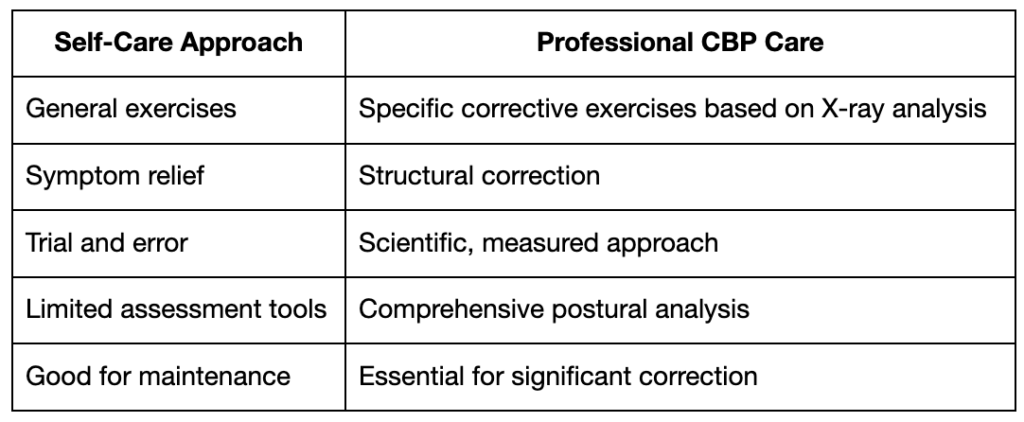Poor posture has become an epidemic in our modern world. Whether you’re hunched over a computer, looking down at your phone, or simply carrying stress on your shoulders, signs of poor posture are everywhere around us.
In this article, we’ll walk you through the nine most common bad posture symptoms and share practical solutions that have helped thousands of our patients stand taller and feel better.
Why Recognizing Poor Posture Matters
Your posture is more than just how you look when standing or sitting. It’s the foundation that determines how your spine, muscles, and joints work together throughout the day. When this foundation shifts, everything else follows.
Poor posture creates a domino effect throughout your body. Your spine loses its natural curves, certain muscles become overworked while others weaken, and your joints face uneven pressure they weren’t designed to handle.
In the short term, posture problems might seem like minor inconveniences. You might feel a little stiff after sitting at your desk or notice tension in your neck after a long day. However, these early warning signs often escalate into more serious issues.
Long-term effects of poor posture include herniated discs, arthritis, reduced lung capacity, digestive issues, and even changes in mood and energy levels. What starts as a simple slouch can evolve into complex health challenges that impact every aspect of your life.
See more: Is There a Perfect Posture
Common Signs of Poor Posture
1. Rounded Shoulders & Slouching
Rounded shoulders are perhaps the most visible sign of poor posture in our digital age. This forward positioning of the shoulder blades creates a cascade of problems throughout the upper body.
When your shoulders round forward, your chest muscles tighten while your upper back muscles stretch and weaken. This imbalance pulls your head forward and increases the curve in your upper back, creating what we call “upper crossed syndrome”.
2. Forward Head Posture (Text Neck)
Forward head posture, commonly called “text neck”, occurs when your head moves ahead of your shoulders. For every inch your head moves forward, it effectively doubles the weight your neck muscles must support.
This excessive strain leads to muscle fatigue, tension headaches, and increased risk of cervical disc problems. We often see this condition in people who spend hours looking at phones, tablets, or poorly positioned computer monitors.
3. Hunched or Kyphotic Upper Back
A hunched back, medically known as hyperkyphosis, represents an excessive curve in the upper spine. While some curves are normal and healthy, too much creates the characteristic “hunchback” appearance.
This condition often develops gradually, starting with rounded shoulders and forward head posture. Over time, the vertebrae in your upper back begin to compress on the front side, potentially leading to wedge-shaped deformities.
4. Tilted Pelvis (Anterior/Posterior)
Your pelvis serves as the foundation for your entire spine. When it tilts too far forward (anterior pelvic tilt) or backward (posterior pelvic tilt), it affects everything above it.
- Anterior pelvic tilt is common in people with tight hip flexors and weak abdominal muscles. This creates an exaggerated arch in the lower back and often leads to lower back pain.
- Posterior pelvic tilt, while less common, flattens the natural curve of the lower back and can cause stiffness and discomfort.
5. Uneven Hips or Shoulders
Uneven hips or shoulders often indicate muscle imbalances or structural issues that need attention. When one side of your body compensates for weakness or tightness on the other side, it creates visible asymmetries.
These imbalances can stem from habits like carrying a bag on one shoulder, sitting with crossed legs, or sleeping in the same position night after night. Over time, these patterns become ingrained in your muscle memory and require targeted intervention to correct.
6. Recurring Headaches & Tension
Tension headaches are one of the most common bad posture symptoms we treat. When your neck and shoulder muscles work overtime to support poor head positioning, they develop trigger points and areas of chronic tension.
7. Muscle Fatigue, Stiffness, or Weakness
Poor posture forces certain muscles to work constantly while others become dormant. This imbalance leads to chronic fatigue in overworked muscles and weakness in underused ones.
For example, people with forward head posture often develop extremely tight and fatigued neck muscles while their deep neck flexors become weak and inhibited. This pattern creates a cycle where the problem perpetuates itself.
8. Chronic Back, Neck, or Shoulder Pain
Chronic pain is often the symptom that finally brings people to our office. While pain might seem like the primary problem, it’s usually a symptom of underlying postural dysfunction.
9. Subtle Signs: Uneven Clothing Fit, Reduced Lung Capacity, Difficulty Standing Tall
Some posture problems manifest in ways you might not immediately connect to spinal alignment. If your clothes hang unevenly, you find yourself getting winded easily, or you struggle to stand up straight without effort, these could be signs of postural dysfunction.
Poor posture can reduce lung capacity by up to 30% by compressing the ribcage and limiting diaphragm movement. This affects oxygen delivery throughout your body and can impact energy levels and cognitive function.
How to Correct and Improve Posture
Daily Stretches & Strengthening Exercises
Effective posture correction starts with addressing the muscle imbalances that maintain poor alignment. This involves stretching tight muscles and strengthening weak ones.
Key stretches for posture improvement:
- Chest doorway stretches to open rounded shoulders
- Upper trap stretches to release neck tension
- Hip flexor stretches to correct anterior pelvic tilt
- Thoracic spine extension exercises to counteract hunching
Essential strengthening exercises:
- Deep neck flexor strengthening for forward head posture
- Rhomboid and mid-trap exercises for shoulder blade stability
- Core strengthening to support spinal alignment
- Glute activation to stabilize the pelvis
Ergonomic Workstation Setup
Since many postural problems develop from prolonged sitting, creating an ergonomic workspace is crucial for long-term success.
Your monitor should be at eye level, your feet should rest flat on the floor and your chair should support the natural curve of your lower back. The keyboard and mouse should be positioned to keep your shoulders relaxed and your wrists in a neutral position.
Breaks & Movement Habits
Research shows that prolonged static postures are more damaging than the specific position itself. Taking regular breaks to move and change positions can significantly reduce the negative effects of desk work.
We recommend the 20-20-20 rule: every 20 minutes, look at something 20 feet away for 20 seconds, and add some gentle neck and shoulder movements. Every hour, stand up and walk around for at least 2-3 minutes.
Supportive Footwear & Lifestyle Changes
Your feet are the foundation of your entire postural chain. Shoes that provide proper arch support and cushioning help maintain optimal alignment throughout your body.
High heels, worn regularly, can contribute to anterior pelvic tilt and increased lower back curve. Flat shoes without arch support can cause the feet to collapse inward, affecting knee and hip alignment.
The Role of Chiropractic & Chiropractic BioPhysics
While self-care strategies are important, some postural problems require professional intervention to achieve lasting correction. Chiropractic care, particularly using Chiropractic BioPhysics principles, offers precise, scientific approaches to postural restoration.
CBP uses specific exercises, manual therapy techniques, and sometimes specialized equipment to restore optimal spinal curves and alignment. This approach goes beyond simply treating symptoms to address the underlying structural causes of postural dysfunction.

Take the Next Step Toward Better Posture
Recognizing the signs of poor posture is the first step toward better health and vitality. While the information in this article provides a solid foundation, every person’s postural challenges are unique and often require personalized assessment and treatment.
At DeCarlo Chiropractic, we’ve helped thousands of patients in New City, NY overcome postural problems using advanced Chiropractic BioPhysics techniques. Our comprehensive approach combines precise analysis with targeted treatment plans designed to create lasting structural improvements.
Don’t let poor posture continue to impact your health and quality of life. Schedule a comprehensive posture assessment today and discover how proper spinal alignment can transform how you feel and function.
FAQs
Can bad posture cause scoliosis?
While poor posture doesn’t directly cause structural scoliosis, it can create functional curves that mimic scoliotic patterns. Additionally, poor posture can worsen existing scoliotic curves and accelerate their progression.
Can poor posture stunt growth or affect height?
Poor posture can make you appear shorter and, in severe cases, actually compress the spine enough to reduce your functional height. In growing children and adolescents, chronic poor posture might influence spinal development.
Is poor posture permanent?
Poor posture is rarely permanent, though correction becomes more challenging the longer patterns are established. With consistent effort and proper guidance, most people can achieve significant improvement regardless of age.
Do posture correctors really work?
Passive posture correctors can provide temporary relief and awareness, but they don’t address the underlying muscle imbalances that create poor posture. They’re best used as part of a comprehensive approach that includes strengthening and mobility work.

